Having a thriving aquarium is a rewarding experience, but the battle against algae growth can be challenging. The key to a clean and vibrant aquatic environment is finding the right algae eaters for your freshwater tank. In this article, we’ll explore the 10 best freshwater algae eaters that can help keep your aquarium free from excessive algae. Let’s dive in and learn more about these fantastic aquatic helpers.
Top 10 Best Algae Eaters Freshwater
1. Siamese Algae Eater
The Siamese Algae Eater (Crossocheilus oblongus) is a popular choice among aquarium enthusiasts. These small, sleek fish are known for their voracious appetite for various types of algae. They’re especially effective at controlling hair algae and can thrive in community tanks.
- Effective against hair algae.
- Ideal for community tanks.
- Sleek and small fish.
Appearance: Siamese Algae Eaters have a sleek and elongated body with a silver or gold coloration. They have a distinctive black horizontal stripe that runs from the head to the tail. This stripe is an important identifying feature.
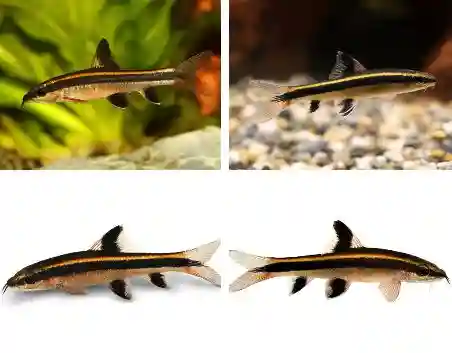
Behavior: These fish are known for being active and fast swimmers. They are relatively peaceful and can be kept with a variety of other fish species. However, they can become territorial towards their own kind, especially if kept in small groups.
Diet: Siamese Algae Eaters are primarily herbivores. They are excellent algae eaters and can help keep your aquarium clean by consuming various types of algae, including diatoms, green algae, and even some types of black beard algae. However, it’s important to note that they might start looking for alternative food sources if algae become scarce, so providing them with a varied diet is advisable. You can supplement their diet with high-quality sinking pellets, flakes, and blanched vegetables like zucchini or spinach.
Tank Requirements: For keeping Siamese Algae Eaters, it’s recommended to have a tank of at least 20 gallons, although a larger tank is always better. They appreciate ample swimming space and the presence of hiding spots like rocks, driftwood, and plants. A well-maintained aquarium with stable water parameters is essential for their health.
Compatibility: Siamese Algae Eaters are generally peaceful and can be kept with a variety of community fish. However, they might exhibit some aggression towards their own species, especially if they are kept in small groups. Providing them with enough space and hiding spots can help minimize this behavior.
Care Tips:
- Maintain good water quality by regularly testing and changing the water.
- Provide a varied diet to ensure their nutritional needs are met.
- Ensure a well-lit aquarium to promote algae growth, which will be their primary food source.
- Keep them in groups of three or more to reduce aggression among themselves.
- Avoid keeping them with fin-nipping or aggressive fish.
The Siamese Algae Eater is a valuable addition to a freshwater aquarium due to its algae-eating abilities and active nature. With proper care and a suitable environment, they can be a beneficial and attractive addition to your aquatic setup.
2. Amano Shrimp
Amano Shrimp (Caridina multidentata) are excellent algae scavengers. These little shrimp are efficient at cleaning up both green and brown algae. They’re peaceful and make great additions to planted aquariums.
- Excellent scavengers for green and brown algae.
- Peaceful and suitable for planted tanks.
- Small, adding to the aesthetics of the tank.
Appearance: Amano Shrimp are translucent with a somewhat transparent body, allowing you to see their internal organs and digestive tract. They have a distinctive appearance with long antennae and a curved, flattened body. They are typically a grayish color, although their appearance can vary based on their diet and environment.
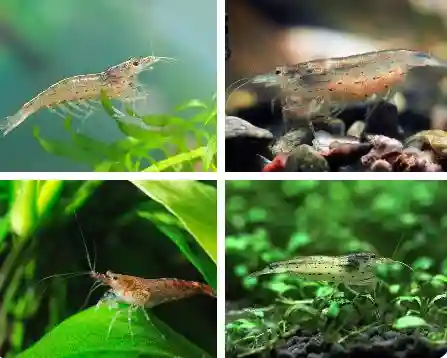
Behavior: These shrimp are known for being excellent algae eaters and are often added to aquariums to help control algae growth. They are peaceful and generally get along well with other peaceful fish and shrimp species. Amano Shrimp are active scavengers, constantly foraging for food.
Diet: Amano Shrimp are primarily herbivores and have a strong appetite for various types of algae, including common types like green algae and diatoms. They are particularly effective at cleaning aquarium glass and decorations. If the algae supply becomes limited, they can also be fed sinking pellets, blanched vegetables like spinach or zucchini, and specialized shrimp foods.
Tank Requirements: For keeping Amano Shrimp, it’s important to provide them with a well-established aquarium with stable water parameters. A tank size of at least 10 gallons is recommended, but larger tanks are even better, especially if you plan to keep them in a community with other fish or shrimp. They appreciate a well-planted tank with hiding spots and ample surfaces for algae growth.
Compatibility: Amano Shrimp are generally peaceful and can be kept with a variety of community fish and other shrimp species. However, be cautious with larger fish that might view them as potential snacks. Avoid keeping them with aggressive or fin-nipping fish.
Care Tips:
- Maintain good water quality by performing regular water changes and testing water parameters.
- Provide hiding spots and plenty of surfaces for algae growth.
- Ensure a well-balanced diet, including algae and supplemental foods.
- Keep in mind that Amano Shrimp are known jumpers, so having a secure lid for the aquarium is important.
- Monitor their behavior and appearance to catch any signs of stress or illness early.
In conclusion, Amano Shrimp are highly beneficial additions to freshwater aquariums, especially if you’re looking for natural algae control. Their unique appearance and behavior make them interesting to observe, and their algae-eating habits can help maintain a clean and balanced aquarium ecosystem.
3. Nerite Snails
Nerite Snails (Neritina spp.) are small, attractive snails that are renowned for their algae-eating abilities. They won’t reproduce in freshwater, which is a plus for those concerned about snail populations exploding. They come in various patterns and sizes, adding a touch of elegance to your tank.
- Varied patterns and sizes.
- Won’t reproduce in freshwater.
- Efficient algae eaters.
Appearance: Nerite Snails have small, rounded shells that can come in various colors and patterns, such as zebra stripes, leopard spots, and more. Their shells are quite distinct and add visual interest to aquariums. The snails themselves have a sturdy bodies and a pair of tentacles with eyes at the tips.

Behavior: These snails are renowned algae eaters, constantly grazing on surfaces to consume different types of algae, including diatoms, green algae, and even some forms of blue-green algae. They are not known for reproducing successfully in freshwater aquariums, which makes them a desirable choice for hobbyists concerned about snail overpopulation.
Diet: Nerite Snails are primarily herbivores, focusing on consuming algae. They might also feed on biofilm and organic debris in the aquarium. If the algae in the tank become insufficient, you can supplement their diet with algae wafers or blanched vegetables like zucchini.
Tank Requirements: For keeping Nerite Snails, ensure your aquarium has stable water parameters and good water quality. They prefer a well-established tank with plenty of surfaces for algae growth. A lid is recommended, as these snails can sometimes climb out of the water.
Compatibility: Nerite Snails are generally peaceful and can be kept with a variety of fish, shrimp, and other snail species. They won’t harm plants or other tank inhabitants. However, be aware that some fish species might try to harass or nibble on them, so choose tankmates carefully.
Care Tips:
- Provide a varied diet to ensure the snails receive adequate nutrition.
- Regularly clean the aquarium to prevent excessive buildup of organic matter and detritus.
- Keep an eye on water parameters, especially ammonia, nitrite, and nitrate levels.
- Monitor the snails for any signs of stress, illness, or abnormal behavior.
In summary, Nerite Snails are fantastic additions to aquariums, offering both practical algae control and attractive aesthetics. Their unique shell patterns and algae-eating habits make them beneficial for maintaining a clean and balanced aquarium environment.
4. Otocinclus Catfish
Otocinclus Catfish (Otocinclus spp.) are fantastic algae eaters, particularly for smaller tanks. They have a gentle disposition and enjoy hanging out on plant leaves, gobbling up algae as they go. These catfish are a great addition to community tanks.
- Perfect for smaller tanks.
- Gentle and peaceful disposition.
- Feeds on algae while hanging out on plant leaves.
Appearance: Otocinclus Catfish are small, slender fish with a flattened body and a sucker-like mouth. They have a light coloration with a translucent look, and their appearance might vary slightly depending on their health and diet. They’re commonly recognized by their large eyes and distinctive body shape.
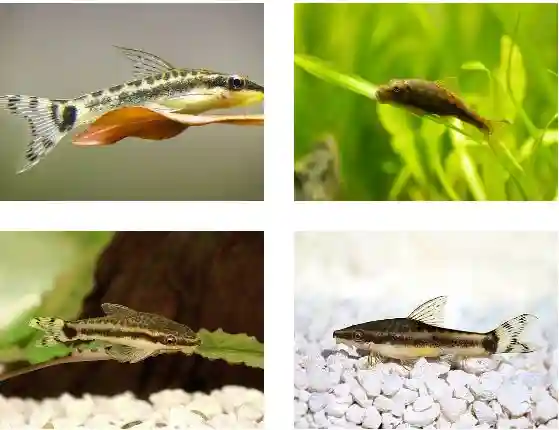
Behavior: Otocinclus Catfish are renowned for their efficient algae consumption. They tend to stay near surfaces and glass, grazing on various forms of algae, including diatoms and soft green algae. Their peaceful nature makes them ideal for community aquariums.
Diet: As primarily herbivorous fish, Otocinclus Catfish mainly feed on algae. They may also consume biofilm and microscopic organisms present on surfaces. In aquariums with insufficient algae, you can supplement their diet with algae wafers or blanched vegetables like zucchini.
Tank Requirements: When housing Otocinclus Catfish, maintain a stable and well-maintained aquarium with good water quality. A tank size of at least 10 gallons is recommended, with ample hiding spots and surfaces for algae growth. They appreciate planted tanks with driftwood and rocks.
Compatibility: Otocinclus Catfish are peaceful and can be kept with a variety of peaceful community fish, shrimp, and snails. Avoid aggressive or fin-nipping tankmates, as they can stress out the Otos.
Care Tips:
- Monitor water parameters, especially ammonia, nitrite, and nitrate levels. Keep them within appropriate ranges.
- Avoid sudden changes in water parameters, as Otocinclus Catfish can be sensitive to fluctuations.
- Provide a varied diet to ensure they receive sufficient nutrition.
- Be cautious when using medications or treatments, as Otos can be sensitive to certain chemicals.
- Observe their behavior regularly to catch any signs of stress or illness.
Otocinclus Catfish are excellent additions to community aquariums, contributing to algae control and adding a unique touch to their appearance and behavior. By providing a suitable environment and diet, you can enjoy their beneficial role in maintaining a clean and harmonious aquatic ecosystem.
5. Bristlenose Pleco
The Bristlenose Pleco (Ancistrus spp.) is a popular choice for many aquarium keepers. With their unique appearance and impressive algae-eating skills, these small plecos are excellent additions to your tank. They’re especially skilled at tackling algae on driftwood and rocks.
- Unique appearance.
- Great for driftwood and rock algae.
- Adds diversity to the tank.
Appearance: Bristlenose Plecos are characterized by their flattened bodies and rows of fleshy “whiskers” or bristles on their snouts. These bristles are more pronounced in males and give them a unique and charming look. They come in various colorations, including shades of brown, albino, and calico.
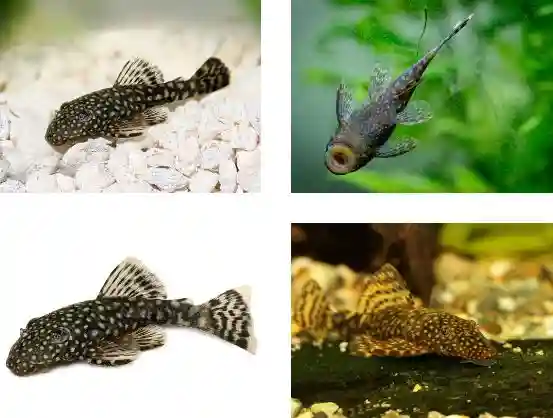
Behavior: These catfish are valued for their effective algae consumption and their tendency to graze on surfaces in search of food. They are generally peaceful and can coexist with various tankmates, although males might become territorial toward other males.
Diet: Bristlenose Plecos are considered omnivores with a strong preference for plant-based foods. They are excellent algae eaters and will consume various types of algae in the aquarium. Additionally, they appreciate vegetable matter such as blanched zucchini, spinach, and specialized sinking foods.
Tank Requirements: When caring for Bristlenose Plecos, provide a well-maintained aquarium with stable water parameters. A tank size of at least 20 gallons is recommended to offer sufficient space for these catfish. They appreciate hiding spots like caves, driftwood, and rocks, where they can retreat and feel secure.
Compatibility: Bristlenose Plecos are generally peaceful and can be kept with a variety of community fish. However, keep in mind that they can become territorial, especially males during the breeding season. Avoid housing multiple males in a small tank to prevent conflicts.
Care Tips:
- Maintain good water quality by performing regular water changes and monitoring water parameters.
- Offer a varied diet to ensure their nutritional needs are met.
- Provide hiding spots and caves, as well as driftwood for them to rasp on (which helps with their digestion).
- Avoid sudden changes in water conditions, as Bristlenose Plecos can be sensitive to fluctuations.
- Observe their behavior and appearance for any signs of stress or health issues.
In summary, Bristlenose Plecos are popular choices for aquariums due to their algae-eating habits and unique appearance. By creating a suitable environment and providing proper care, you can enjoy the benefits of their natural algae control while appreciating their charming and distinct features.
6. Reticulated Hillstream Loach
Reticulated Loach or Reticulated Butterfly Sucker, is a fascinating and unique freshwater fish species that is well-suited for aquariums with fast-flowing water. Here’s some information about the Reticulated Hillstream Loach and how to care for them:
Appearance: The Reticulated Hillstream Loach has a flat and streamlined body, perfect for clinging to surfaces in fast-flowing water. They have a unique reticulated (net-like) pattern on their body, which gives them their name. Their coloration can range from light to dark shades, often blending in with their environment.
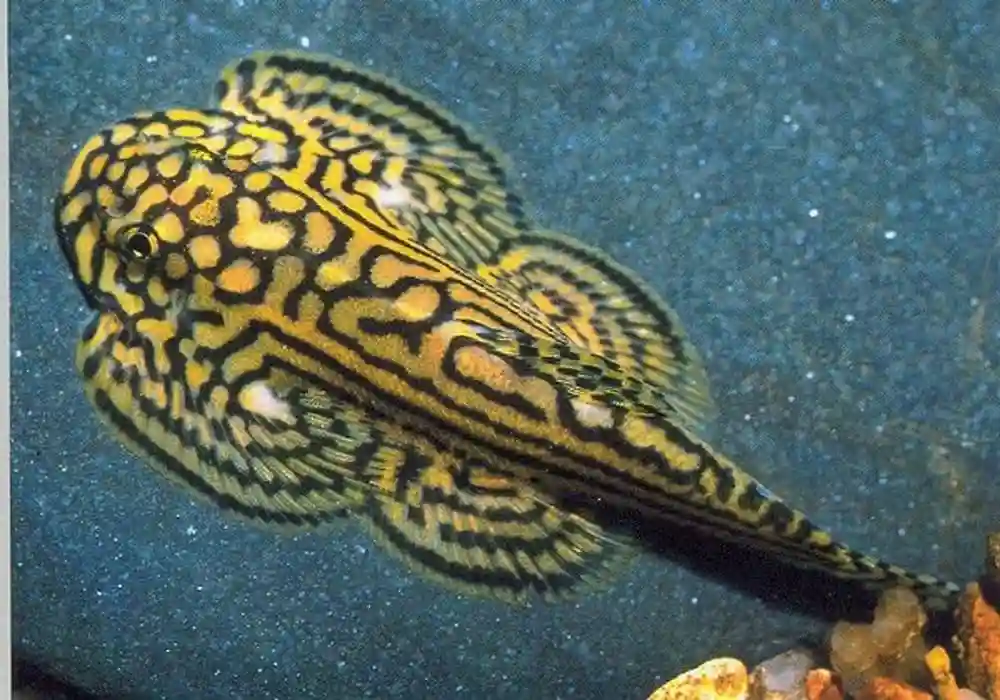
Behavior: These loaches are adapted to live in fast-flowing streams, which is reflected in their behavior. They are excellent swimmers and have specialized adaptations that allow them to cling to surfaces like rocks and aquarium decorations even in strong currents.
Diet: Reticulated Hillstream Loaches are primarily algae eaters, feeding on biofilm and algae that grow on rocks and surfaces in their habitat. They might also consume small invertebrates and organic debris. In the aquarium, they will graze on algae but might also accept algae wafers or sinking pellets.
Tank Requirements: When setting up an aquarium for Reticulated Hillstream Loaches, it’s important to replicate their natural environment. Provide strong water flow, which can be achieved using powerheads or specialized equipment. Smooth rocks, caves, and other decorations that create water currents and offer surfaces for clinging are essential. Tank size should be at least 20 gallons to provide adequate swimming and resting spaces.
Compatibility: These loaches are generally peaceful and can be kept with other fast-moving fish species that appreciate strong water flow. Avoid housing them with slow-moving or long-finned fish that might outcompete them for food or cause stress.
Care Tips:
- Maintain excellent water quality by performing regular water changes and maintaining stable water parameters.
- Provide strong water flow using suitable equipment to mimic their natural habitat.
- Ensure surfaces like rocks and decorations are smooth to prevent damage to their delicate bodies.
- Offer a varied diet to ensure they receive adequate nutrition.
- Keep an eye on their interactions and behavior to catch any signs of stress or illness.
The Reticulated Hillstream Loach is a unique and captivating addition to aquariums that mimic their fast-flowing natural habitats. By creating a suitable environment and providing proper care, you can observe their fascinating behavior and appreciate their adaptation to life in challenging currents.
7. Cherry Shrimp
Cherry Shrimp (Neocaridina davidi) are not only colorful but also diligent algae eaters. They are relatively easy to care for and can thrive in planted tanks. Their small size makes them suitable for nano aquariums.
- Colorful and diligent algae eaters.
- Suitable for nano tanks.
- Thrive in planted environments.
Appearance: Cherry Shrimp are known for their bright red coloration, which can range from pale orange-red to deep crimson. They have a sleek and streamlined body, and their color intensifies as they molt and grow. There are also different color variants of Neocaridina shrimp available, including yellows, blues, and greens.
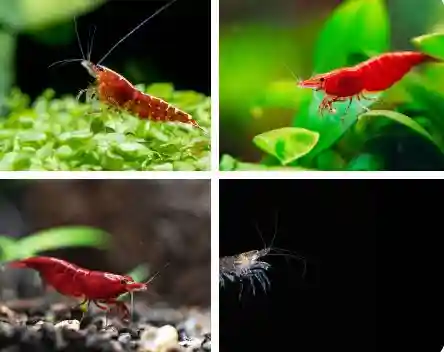
Behavior: Cherry Shrimp are active and social creatures that spend their time grazing on surfaces, exploring plants, and interacting with their environment. They are generally peaceful and coexist well with other non-aggressive tankmates.
Diet: These shrimp are primarily herbivores and omnivores. They feed on algae, biofilm, and detritus in the aquarium. Providing a well-planted tank with surfaces for algae growth will ensure a natural food source. You can supplement their diet with specialized shrimp pellets, blanched vegetables like spinach or zucchini, and occasionally small amounts of high-quality fish food.
Tank Requirements: When keeping Cherry Shrimp, maintain a well-maintained and established aquarium with stable water parameters. A tank size of at least 5 gallons is suitable for a small colony of shrimp. They appreciate hiding spots like plants, moss, and decorations. Be sure to have a secure lid, as they might try to climb out of the water.
Compatibility: Cherry Shrimp are generally peaceful and can be kept with other peaceful fish and shrimp species. However, be cautious when selecting tankmates, as some fish might view them as prey. Small and non-aggressive fish like tetras, rasboras, and dwarf corydoras are often good choices.
Breeding: Cherry Shrimp are prolific breeders under proper conditions. They will breed readily in the aquarium if provided with ample hiding spots, plants, and good water quality. The young shrimp are miniature versions of the adults and will grow over time.
Care Tips:
- Monitor water parameters, especially ammonia, nitrite, and nitrate levels.
- Provide regular water changes to maintain water quality.
- Avoid using copper-based medications, as they can be harmful to shrimp.
- Be cautious when using aquarium additives or chemicals, as shrimp can be sensitive to certain substances.
- Observe their behavior and appearance regularly to catch any signs of stress, illness, or molting issues.
In conclusion, Cherry Shrimp are popular and enjoyable additions to freshwater aquariums. With their vibrant colors and active behavior, they add vibrancy and life to your aquatic setup. By creating a suitable environment and providing proper care, you can watch these shrimp thrive and even witness their natural breeding behavior.
8. Twig Catfish
Twig Catfish (Farlowella spp.) are unique-looking algae eaters, resembling sticks or twigs. They have an incredible ability to blend in with their surroundings while diligently munching on algae-covered surfaces. These catfish prefer driftwood, making them an excellent choice for aquascapes.
- Unique appearance resembling sticks.
- Blends in with surroundings.
- Prefers driftwood, great for aquascapes.
Appearance: Twig Catfish are easily recognized by their slender, elongated body that resembles a twig or stick. They have a flattened appearance and typically come in shades of brown, which aids in their camouflage among aquatic plants. Some species might also have subtle markings or patterns on their bodies.

Behavior: Twig Catfish are peaceful and relatively shy by nature. They are primarily bottom-dwellers and are known for their skill at clinging to surfaces, such as plants and wood. They might spend a lot of their time perching on these surfaces, resembling actual twigs.
Diet: Twig Catfish are primarily herbivorous, and their diet mainly consists of algae and biofilm. In the aquarium, they will graze on surfaces, such as plants and decorations, for food. However, they might also accept sinking pellets or blanched vegetables as supplemental food.
Tank Requirements: When caring for Twig Catfish, provide an aquarium with ample hiding spots and surfaces to cling to. A well-planted tank with driftwood, rocks, and other decorations will create a suitable environment. Ensure that the water parameters are stable and appropriate for your specific species of Twig Catfish.
Compatibility: Twig Catfish are generally peaceful and can be kept with other non-aggressive fish species. They are particularly well-suited to community tanks with other peaceful bottom-dwellers. Avoid housing them with aggressive or fin-nipping fish that might stress them out.
Care Tips:
- Maintain good water quality by performing regular water changes and monitoring water parameters.
- Provide hiding spots such as caves, plants, and decorations to make them feel secure.
- If keeping multiple Twig Catfish, ensure that there’s enough space for each to establish their territory.
- Offer a varied diet to ensure their nutritional needs are met.
- Avoid strong water currents, as these catfish prefer calmer waters.
In conclusion, Twig Catfish are captivating and unusual additions to aquariums, bringing a unique appearance and behavior to your tank. By creating an environment that mimics their natural habitat and providing proper care, you can enjoy observing these catfish as they navigate their twig-like surroundings and interact with their aquatic companions.
9. Florida Flagfish
The Florida Flagfish (Jordanella floridae) is a lesser-known but highly effective algae eater. This fish has a vibrant appearance and is particularly skilled at consuming filamentous algae. They are also peaceful and can coexist with other community fish.
- Vibrant appearance.
- Skilled at consuming filamentous algae.
- Peaceful coexistence with other community fish.
Appearance: Florida Flagfish have an eye-catching appearance, with males exhibiting bold, bright colors. They have a distinct flag-like dorsal fin, which is how they get their common name. Males often display colors ranging from yellow to orange, with iridescent blue-green markings. Females are generally less colorful and have a more subdued appearance.
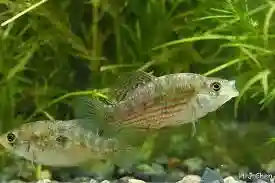
Behavior: Florida Flagfish are known for their active behavior and willingness to explore their surroundings. They are surface-oriented fish and spend a lot of their time near the water’s surface. Males might engage in territorial behavior, especially during breeding.
Diet: These fish are omnivores with a preference for small invertebrates and insect larvae. In the aquarium, they will accept a variety of foods, including high-quality flakes, pellets, frozen or live foods, and even small pieces of vegetables.
Tank Requirements: When keeping Florida Flagfish, provide a well-maintained aquarium with stable water parameters. A tank size of at least 20 gallons is suitable for a small group of these fish. They appreciate a planted tank with open swimming spaces and hiding spots. A tight-fitting lid is advisable, as they are jumpers.
Compatibility: Florida Flagfish are generally peaceful but can exhibit territorial behavior, especially among males. They can be kept with other non-aggressive community fish species, but it’s recommended to avoid keeping multiple males in a small tank to prevent conflicts.
Breeding: These fish are known for their unique method of reproduction. They are killifish, and their eggs can survive out of water for a period of time. If conditions are suitable, the eggs can hatch when they are returned to water. Breeding them might require specific conditions and some attention to details.
Care Tips:
- Maintain good water quality by performing regular water changes and monitoring water parameters.
- Provide a varied diet to ensure their nutritional needs are met.
- Create hiding spots and open swimming spaces to accommodate their behavior.
- Keep an eye on their interactions, especially if housing multiple males, to prevent aggression.
- Pay attention to their coloration and behavior, as any drastic changes could indicate stress or illness.
In conclusion, Florida Flagfish are captivating and colorful additions to freshwater aquariums. By offering proper care and creating an environment that suits their natural behaviors, you can enjoy observing their vibrant colors and active movements in your aquatic setup.
10. Goldfish
Goldfish (Carassius auratus) are not only charming but can also serve as efficient algae eaters in larger tanks. However, it’s important to ensure the tank is appropriately sized for the goldfish, as they can grow quite large.
- Efficient in larger tanks.
- Beautiful and charming fish.
- Requires appropriately sized tanks as they grow.
Appearance: Goldfish come in various colors, shapes, and sizes due to selective breeding. They are known for their distinctive body shapes, including the common “single-tail” and “double-tail” varieties. Colors range from shades of orange to white, black, red, and even calico patterns.
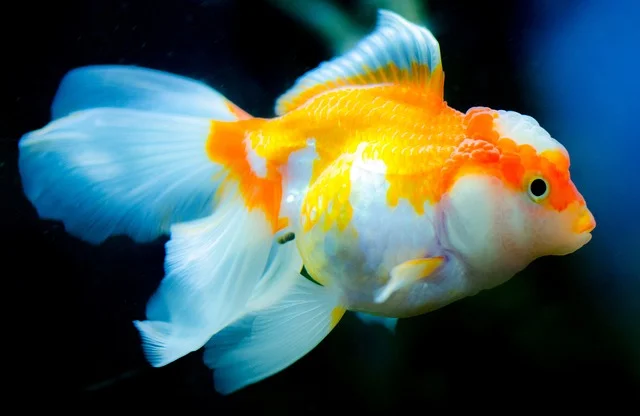
Behavior: Goldfish are generally active and curious fish. They are social creatures and can be kept in groups, although they might occasionally display territorial behavior, especially during feeding. They often interact with their environment and are known to forage for food at the bottom of the tank.
Diet: Gold fish are omnivores and have a varied diet. They will eat high-quality flakes, pellets, and granules formulated specifically for goldfish. Additionally, they enjoy fresh vegetables like peas, spinach, and zucchini. Be cautious not to overfeed, as excess food can lead to water quality issues.
Tank Requirements: When caring for gold fish, provide a spacious aquarium or pond to accommodate their growth. Gold fish have the potential to reach significant sizes, depending on the variety. A larger tank with good filtration is essential for maintaining water quality. Decorate the tank with gravel or smooth substrates and avoid sharp decorations that could injure their delicate fins.
Compatibility: It can be kept together, but avoid mixing them with tropical fish, as they have different temperature requirements. It’s best to house gold-fish with other goldfish or other coldwater fish species that share similar water temperature needs.
Care Tips:
- Maintain good water quality by performing regular water changes and monitoring water parameters like ammonia, nitrite, and nitrate levels.
- Avoid overcrowding the tank to prevent stress and water quality issues.
- Provide adequate filtration and aeration, as goldfish are sensitive to poor water conditions.
- Be cautious with feeding to prevent overeating and associated health problems.
- Monitor for signs of illness or behavioral changes and take action if needed.
In conclusion, goldfish are classic and captivating aquatic pets with a long history of popularity. By offering them proper care, a suitable environment, and attention to their unique needs, you can enjoy the beauty and charm of these beloved fish in your own aquarium or pond.
FAQs
-
How often should I feed my algae eaters?
Algae eaters should be fed once a day with an amount they can consume within a few minutes. Overfeeding can lead to water quality issues.
-
Will algae eaters harm my other fish?
Most algae eaters are peaceful, but some, like the Chinese Algae Eater, can become aggressive as they mature. Choose algae eaters that are compatible with your tank’s inhabitants.
-
Can I rely solely on algae eaters to control algae?
While algae eaters help, it’s essential to maintain a balanced tank with proper lighting, water parameters, and routine maintenance to control algae effectively.
-
Do algae eaters require special care?
Some algae eaters, like Otocinclus Catfish, are sensitive to water conditions. Ensure your tank is well-established and cycled before adding them.
-
Can I keep multiple species of algae eaters in the same tank?
Yes, you can, but ensure they have adequate space and compatible behavior.
-
How can I prevent excessive algae growth in my aquarium?
Consistent tank maintenance, proper lighting duration, and avoiding overfeeding can help prevent algae overgrowth.
Conclusion
Maintaining a clean and algae-free aquarium is possible with the right algae eaters. Each species mentioned in this article brings its unique benefits to the table, whether it’s their algae-eating prowess or their compatibility with other fish. By selecting the appropriate algae eaters for your tank’s needs, you can create a beautiful and thriving aquatic ecosystem. Happy aquarium keeping!


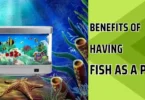


Leave a Comment
You must be logged in to post a comment.